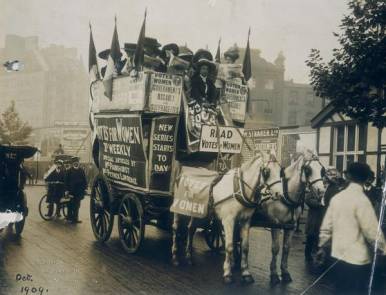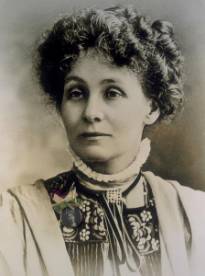Who was Emmeline Pankhurst?
PHOTOGRAPH 1
|
PHOTOGRAPH 2 |
|---|
A quotation: " We are here, not because we are law-breakers; we are here in our efforts to become law-makers."
Emmeline was born in Manchester and married Richard Pankhurst. He was a firm believer in the social and political women. In 1889, both Emmeline Pankhurst and her husband had founded the Women's League.
This movement had a specific agenda but was seen to be hopelessly out of touch with society.
By 1903, Emmeline's daughter, Christabel, had persuaded her mother to form the Women's Social and Political Union (WSPU).
During the famous militant acts of the WSPU, Emmeline Pankhurst took on a decisive role that saw her being arrested on a number of occasions – six times between 1908 and 1912.
As the movement became more militant, so society took a more hard line view on their activities.
|
PHOTOGRAPH 3 |
Description: Emmeline Pankhurst, Honorary Secretary, and later Honorary Treasurer, of the WSPU, c1909 [...]. PHOTO 1 Votes for Women cart, October 1909. A group of suffragettes on board a cart advertising the newspaper "Votes for Women", containing articles by Emmeline Pankhurst and Emmeline Pethick-Lawrence, two of the principal figures of the campaign. Other posters refer to 'Government's assault on suffragettes'. Demonstrations by campaigners were sometimes met with force and many women were injured and sent to prison. PHOTO 2 (1909) PHOTO 3 Emmeline Pankhurst arrested by Superintendent Rolfe outside Buckingham Palace, London, May 1914. Mrs Pankhurst was trying to present a petition to the king. CE: EMMELINE PANKHURST |
|---|
The 1913 Derby and the act of Emily Wilding Davison outraged society.
However, during World War One, Emmeline Pankhurst encouraged all women to do what they could for the war effort.
There is a definite link between the work women did in World War One and their emancipation - though historians have questioned just how important that link was.
In 1919, Emmeline Pankhurst emigrated to Canada having left the Independent Labour Party. She stayed in Canada until 1926.
For many people, Emmeline Pankhurst symbolises the women made at the start of the 20th century– a struggle that garnered its fruit in 1918.
P.S.: pages created by Mrs GELY for her students


